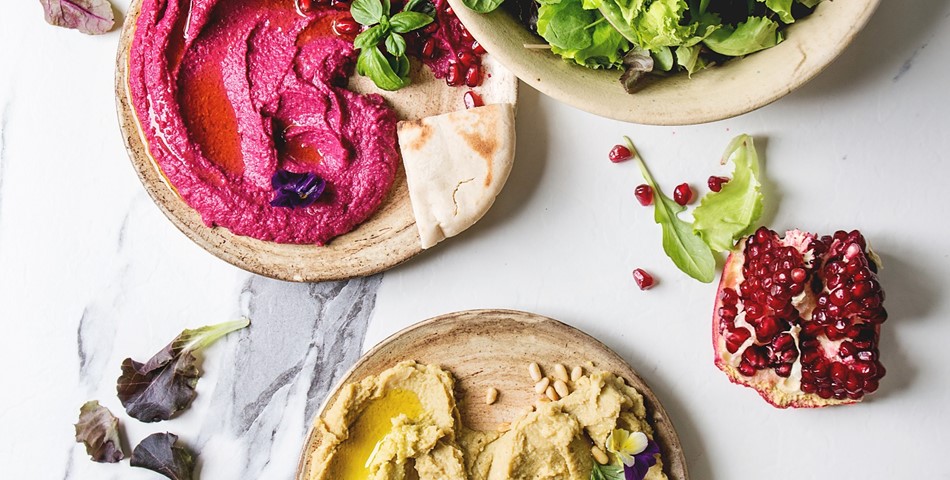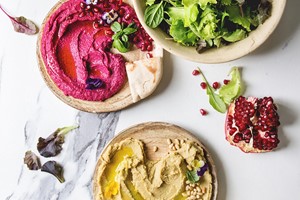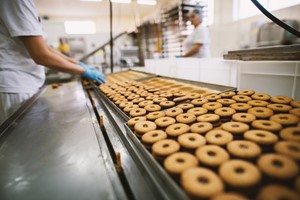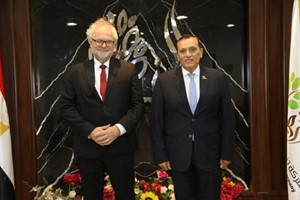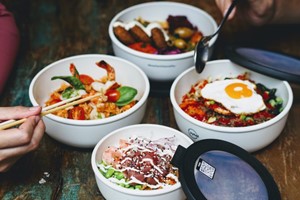At the time of data collection and analysis, our region had not yet experienced the social and economic consequences of the outbreak of COVID-19. While the F&B landscape is expected to change, with restaurants facing cash-flow and operational restrictions, we remain positive in our outlook for the industry’s growth and the shift in trends. Saudi Arabia’s Food and Beverage (F&B) industry is the largest in the Middle East, valued at USD 45 billion. The Saudi Arabian General Authority for Investment (SAGIA) forecasts that spending on foodservice will grow by 6% per annum over the next five years (far ahead of the overall population growth of 1.8%), with food consumption reaching SAR 221 billion (USD 59 billion) by 2021. This growth is being driven by a number of demographic and social changes sweeping the Kingdom.
Large, young population, with high disposable incomes
Rapidly changing demographics present many opportunities for developing the Food & Beverage industry in Saudi Arabia. With a population approaching 34 million by the end of 2019 Saudi is the largest domestic F&B market in the GCC. More relevant than the overall size of the population, is the relatively young age demographic with 53% between the ages of 15-44. This age group has a higher propensity to spend on F&B, and is more open and exposed to the changing consumer trends being experienced globally.
Expansion of the tourism and entertainment industries
The tourism industry in Saudi Arabia is changing drastically, with public and private sector efforts focused on diversifying the tourist base and purpose of travel to the Kingdom (away from business and religious tourism). In the long run, this is expected to result in a significant shift in the Kingdom’s retail and F&B landscape as part of the government’s modernization and economic diversification efforts. Planned investments in the entertainment sector will also have a major impact on the quality and diversity of F&B concepts in the Kingdom. Vision 2030 envisages that household spending on domestic entertainment will increase from 2.9% of total expenditure in 2015 to 6% by 2030. The expansion of the cinema industry alone is expected to create opportunities for supporting retail and F&B offerings. The planned increase in the number and size of sporting events and concerts will also have positive implications for the foodservice sector. This is already resulting in a proliferation of mobile food and beverages businesses and food trucks. This growth will not just be limited to the major cities of Riyadh and Jeddah. Al Ula in the North West of the Kingdom (and home to Saudi’s first UNESCO World Heritage site) introduced a number of concerts and musical performances under the banner of ‘Winter at Tantora’ in 2019. This event was catered for by a wide range of temporary food trucks and the establishment of a number of fine dining pop up restaurants (including Anabelle’s, Sass Café, and La Cantine).
What we have seen
In line with global trends, the F&B market in Saudi Arabia has already seen many changes and developments:
- A number of world-famous fine dining restaurants have tested the market by opening their first pop-up branches in Saudi Arabia as part of the recent Jeddah and Riyadh Seasons (e.g. Zuma, Scalini, and Catch).
- A variety of international casual and fine dining options have entered the Riyadh market (e.g. Cheesecake Factory, Hakkasan and Cipriani).
- Michelin star level restaurants are opening permanently across the Kingdom (e.g: Rasoy, an Indian restaurant in Jeddah).
- There has been a trend towards new specialty smoke houses in Jeddah and elsewhere (e.g. The Warehouse, Chefs and The Smoke House).
- More specialty third-wave coffee shops are opening across the main cities. These are proving popular locations for friends to gather and socialize, especially among Millennials and Generation Z (e.g. C-Hub, Overdose, Dose, Toga).
- Increasing number of famous local Saudi chefs opening their own restaurants (e.g. Nehal Felemban) or leasing space to give culinary lessons (e.g. Bakery M).
- The first Culinary Arts Academies are planned to open in Jeddah and Riyadh.
- The growing trend of food banks (e.g. Etaam), reflecting people’s awareness & responsibility in preserving food, with wedding and banquet halls now obliged to subscribe to food banks and minimize food waste. It is estimated the Etaam food bank preserved around 2.1 million meals in 2019.
The Restaurant Market in Riyadh and Jeddah: Key Insights
We have analysed data on approximately 9,000 restaurants in Riyadh and Jeddah. This data covers all restaurants and cafes with an online presence and has been sourced from Google Maps® and relevant peer review websites such as Trip Advisor, Foursquare® and Zomato®. Based on population figures from Oxford Economics, we find that Jeddah has a higher ratio of restaurants per capita (1 per 1,090 people) than Riyadh (1 per 1,385 people). This is a reflection of the larger domestic tourist market in Jeddah and the large number of religious tourists that pass-through Jeddah. The Restaurant Market in Riyadh and Jeddah: Key Insights Restaurant mix The mix of restaurants in each city is relatively similar, with a number of standout observations.
- Jeddah has a higher provision of Fast Casual outlets (8% versus 5% in Riyadh), indicating it is a more modern market as this unit category is relatively new, globally.
- Casual Dining in Riyadh (16%) is significantly lower than Jeddah (22%). This disparity is explained by the much higher provision of Fast Food in Riyadh (40%) compared to Jeddah (33%). This is due to the large proportion of low quality, old and traditional establishments in Riyadh, classified as Fast Food, catering to a low-income population. In the upcoming decade, we expect some of these establishments to be gradually replaced by Casual Dining and Fast Casual establishments delivered by international brands and home-grown concepts.
- Refuel & Relax units (such as coffee shops) are the second most common form of outlet, following Fast Food, accounting for 26% of all units in both cities. This provision mix is approximately 50% higher than other global destinations we have studied, due to the fact that Refuel & Relax destinations are currently the dominant “social” commercial spaces available in Saudi. As other social spaces such as Entertainment Clusters, Food Halls and Cinemas increase their presence in the Kingdom, we expect more structured food establishments (Fast Food, Casual and Fast Casual Dining) to supplement a proportion of the Refuel & Relax establishments.
- We find that Modern Fast Casual and All-Day Dining establishments are relatively underprovided in both markets and expect these categories will increase in popularity as new concepts, especially better quality home-grown restaurants, come into the market.
- Ready to Eat and Food Retail are also scarce in both markets. As people become increasingly busy and time poor, we have seen an increase in such concepts globally and expect a similar trend in the Kingdom.
Location analysis
Riyadh Clustering
- As expected, the unit clustering is concentrated in the downtown area of the city.
- On the East of the Riyadh Air Base we find a higher density of restaurants than on the West of the city. This is due to the higher density of population in this area. It is also important to notice than in the East, we find a higher density of Fast Food Restaurants which is in line with our expectations due to the lower income averages in this area.
- The most important observation from this analysis is the increasing supply on the North of the city. When this is coupled with our development supply figures, there is a clear trend of the city growing to the North with high quality supply of both restaurants and other asset classes.
Jeddah Clustering
- Similar to Riyadh, the highest concentration is found in the downtown of Jeddah with one key difference. Jeddah as a city is more condensed and the same is found in the restaurant provision.
- We find two pockets of F&B in the south of the city in the Al Bahad and Corniche areas of the city. These are the “old city” destinations which provide a lower quality restaurant experience.
- Even though the population in the North is limited, in recent years JLL has seen a large increase in restaurant supply on the northern side of the airport (JED), east of the creek. This is supported by developments around the Creek, Jeddah Tower, and other large up and coming commercial centres.
Brands, cuisine types, and reviews
Brands: In addition to the internationally recognizable brands, we have categorized brands as establishments with 3 or more units in each market. Our analysis finds Riyadh’s supply (39%) is significantly more branded than Jeddah (24%). Both markets however, are less branded than other global cities. This is as a result of the expansion strategy of global brands which does not include the Kingdom in their initial expansion plans. Following the strong reforms and 2030 vision push, we expect the branded provision in both Riyadh and Jeddah to increase.
Cuisine Types: In both markets coffee represents the highest provision of units due to the popularity of Refuel and Relax units followed by Middle Eastern restaurants at 16% in Riyadh and 17% for Jeddah. There is little difference in the overall mix of cuisines with Indian/ Pakistani restaurants the third most popular category in both at around 8%. It is important to note that healthy options represent less that 1% in each market. Following global trends, but also due to the young population in the Kingdom, we believe this segment is expected to grow over the next 5 years. We also analyzed over 400,000 reviews, equally split between Riyadh and Jeddah, to find that Jedah’s weighted average rating is 3.64 out of 5 compared to Riyadh’s 3.57. Further detailing the Riyadh market, we find that people mentioned “Food” in positive reviews 22% of the time, were “Service” and “Staff” is mentioned 28% of the time in negative reviews. Similar to Riyadh, in Jeddah, “Service” appears in most negative reviews (21%) and “food” in 26% of the positive ones. It is important to note that “Service”, “Staff”, “Place” and “Experience” appear in 37% of all reviews in Riyadh and over half (51%) of all Jeddah reviews which highlighting the need for better training, sharper service and the importance of the experience not only in terms of service but also look and feel of the restaurant. This will be increasingly important in those areas that are aiming to attract international tourists whose service expectations are often more demanding.
JLL MENA
www.jll-mena.com




